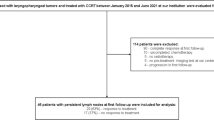Background and Purpose:
Intensity modulated radiation therapy (IMRT) combined treatment approaches, surgical and radiodiagnostic advances, respectively, lead to improved local-regional control in head neck cancer (HNC). With increasing local-regional control, distant metastases (DM) become more meaningful. In some trials without concomitant chemotherapy, induction chemotherapy (IC) resulted in an absolute reduction of DM by ~10–15%. In order to define a more efficient selection of patients at risk for DM with respect to IC and M-staging, we analysed our patients treated by contemporary standards.
Patients and Methods:
Between 1/2002 to 12/2007, 409 HNC patients were treated with IMRT; 303/409 (74%) underwent definitive, 106 (26%) postoperative IMRT. The mean/median follow-up was 23/20 months (3–72). 70% tolerated 4–7, 9% 1–3 cycles of simultaneous cisplatin. Treatment followed a prospectively designed protocol. In a previous study with 172 HNC IMRT patients, gross tumor volume (GTV) was found the strongest predictor for local-regional control. In the current study, this criterion has been prospectively tested for DM. Numbers needed to treat were calculated for IC.
Results:
DM developed in 28/399 (7%) patients; 10 presented initially with DM (total 38/409). In 13/28 (46%), DM remained the only manifestation of disease. GTV was the strongest predictor for DM (p < 0.0001) of all tested. Only 4% of patients with GTV < 70 cc developed DM, vs. 25% (18/73) with > 70 cc; only 6 of them (6/73, 8%) developed isolated DM.
Conclusion:
GTV was the most significant predictor for DM, that could guide selective pre-treatment M-staging. The subgroup with isolated DM in the high risk group, that could benefit from IC, is small.
Hintergrund und Ziel:
Intensitätsmodulierte Radiotherapie (IMRT) zusammen mit Kombinationstherapien, chirurgischen und radiologischen Fortschritten führte zu Verbesserungen der Lokoregionalkontrolle bei Kopf-Hals-Tumoren (KHT), was Fernmetastasierung (DM) bedeutsamer macht. In einigen Studien ohne simultane Chemotherapie resultierte die Induktionschemotherapie (IC) in einer absoluten DM-Reduktion von ~10–15%. Um DM-Hochrisikopatienten besser selektieren zu können hinsichtlich IC wie auch DM-Staging, analysierten wir unser nach modernem Standard behandeltes IMRT-Kollektiv.
Patienten und Methodik:
Von 1/2002 bis 12/2007 wurden 409 KHT-Patienten kurativ IMRT-behandelt: 303/409 (74%) definitiv, 106 (26%) postoperativ (mittlere/mediane Verlaufsbeobachtung 23/20 Monate [3–72]). 70% tolerierten 4–7, 9% 1–3 simultaner Cisplatin-Zyklen (Table 1). Die Therapie folgte einem prospektiv festgelegten Protokoll. In einer früheren Studie mit 172 KHT-Patienten mit definitiver IMRT wurde das „gross tumor volume“ (GTV) als signifikantester Prädiktor für die Lokoregionalkontrolle nachgewiesen. In der hier präsentierten Studie wurde dasselbe volumetrische Staging-System getestet hinsichtlich dessen prädiktiven Wert für DM, um eine allfällige IC wie auch die initiale Metastasensuche selektiver auf ein Hochrisikopatientensegment beschränken zu können.
Ergebnisse:
DM fanden sich bei 38/409 Patienten bzw. bei 28/399 mit initialem M0-Status (7%) (Abbildung 1, Tabelle 2); 10 Patienten hatten initial bereits DM. Bei nur 13/28 (46%) blieben DM die einzige Krankheitsmanifestation. Das GTV erwies sich als signifikantester aller getesteter Metastasenprädiktoren (p < 0,0001, Abbildung 2, Tabelle 3); nur 4% der Patienten mit einem GTV < 70 cc entwickelten DM, vs. 25% (18/73) mit GTV > 70 cc, von diesen nur 6 mit isolierter DM (6/73, 8%).
Schlussfolgerung:
Das GTV war der signifikanteste Voraussageparameter für DM, und könnte als Selektionsparameter für die prätherapeutische DM-Suche dienen. Die Subgruppe mit isolierter Metastasierung in der Hochrisikogruppe, die von einer IC profitieren könnte, ist klein (Tabelle 4).
Similar content being viewed by others
Author information
Authors and Affiliations
Corresponding author
Rights and permissions
About this article
Cite this article
Studer, G., Seifert, B. & Glanzmann, C. Prediction of Distant Metastasis in Head Neck Cancer Patients: Implications for Induction Chemotherapy and Pre-treatment Staging?. Strahlenther Onkol 184, 580–585 (2008). https://doi.org/10.1007/s00066-008-1951-y
Received:
Accepted:
Published:
Issue Date:
DOI: https://doi.org/10.1007/s00066-008-1951-y




